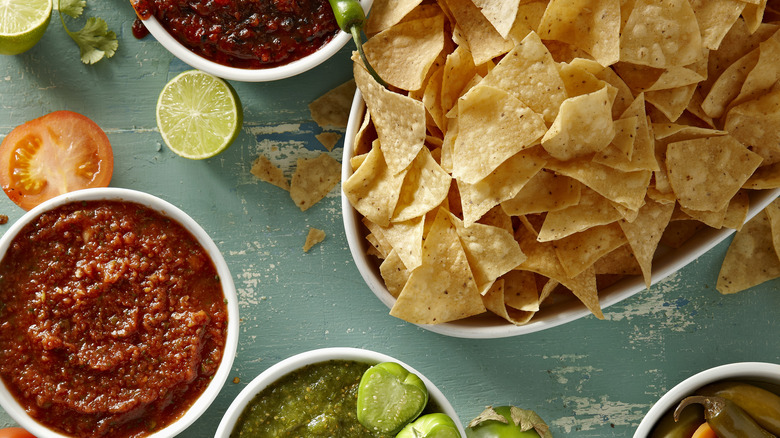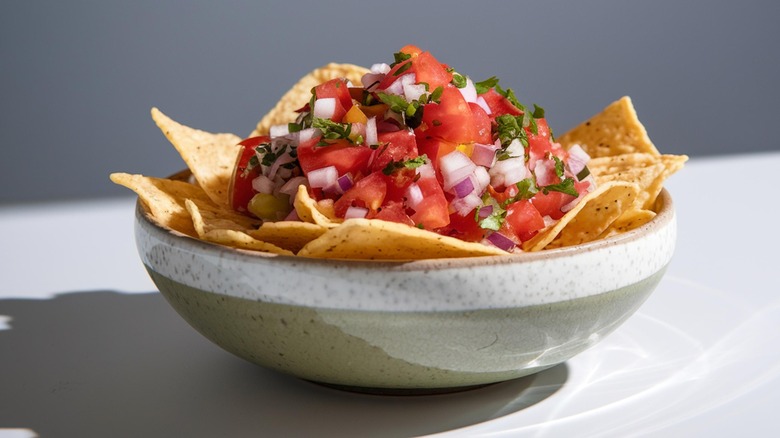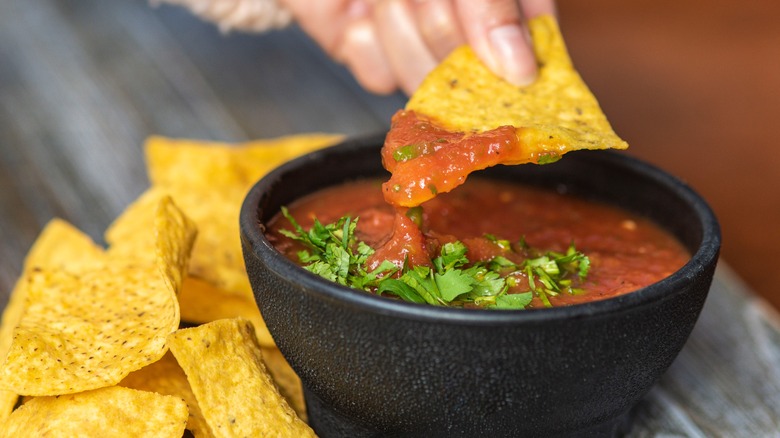Pico De Gallo Vs Salsa: Is There A Difference?
Don't neglect the power of a condiment — a freshly crafted sauce can do wonders to lift up a dish. And while there is a dizzying range of options to sample from around the world, few beat the vibrant flavors of salsa. Often made with tomatoes, onions, chili peppers, and a range of aromatics, the condiment can range from simple to incredibly complex.
The term is so expansive, it may not be apparent as to what foodstuffs fall under its umbrella. So, when you're making a dependable five-ingredient pico de gallo, know you're crafting a specific type of salsa. This particular variety belongs to a group called salsa fresca, a style that emphasizes the freshness of chopped ingredients and a short marination time. It's a wonderfully diverse condiment that's easy to assemble and melds well with many dishes.
When it comes to salsas, pico de gallo's lovable flavor is just the tip of the iceberg, though. From nut and oil varieties to creations with tropical fruit, there's lots to explore. So, when chopping up a bowl of pico de gallo to serve with tortilla chips, consider pairing the snack with another salsa, too. The more types you create, the more flavors you'll be able to enjoy.
Pico de gallo is a chunky, raw rendition of salsa
Unlike the broad possibilities of other salsas, pico de gallo comes defined with a specific combination of ingredients. Coarsely diced tomatoes form the foundation, which is complemented by chopped onions, cilantro, lime, salt, garlic, and chilis. Jalapeños are the most popular pepper addition, although chefs may also choose to use serranos or other varieties for a different flavor. And when it comes to the tomatoes, it's all about ripeness. Roma are a common choice, although cherry or heirloom tomatoes can also end up in the mix. When combined, these components create a fresh and flavorful mix — it's a perfect salsa without much need for modification.
Pico de gallo is sometimes called either salsa fresca or salsa cruda, both of which are categories that reference raw, minimal-intervention salsas made with fresh ingredients. In fact, the terms are often used interchangeably in regards to pico de gallo. So, unlike other salsa styles that might involve a blender or the oven, know that you'll never need any tools other than a knife and a cutting board to make it.
The sky's the limit for pico de gallo applications. The fresh flavor pairs nicely with many foods, from a serving of tacos or enchiladas to a basic burrito bowl of steamed white rice with seasoned chicken breast or fish. And, as with other salsas, it's delicious with tortilla chips, too.
Salsa comes in an extensive range of tastes and textures
Pico de gallo is just one of many types of salsa to explore. The term translates to sauce in Spanish and, accordingly, its composition can vary widely in terms of both ingredients and consistency. Most commonly known are the salsas made from a base of tomatoes, peppers, and seasonings, and blended into a smooth texture. Ingredients can be charred, roasted, fried, and even boiled. Even the range of possible chili peppers inspires diverse flavor profiles, from the smoky, sweet nature of guajillos to bright and tangy serranos.
Furthermore, salsas can be crafted with a base other than tomatoes. You've likely already had a green-colored rendition with a tomatillo base called salsa verde. Such versions pack in delectable tart and fruity notes, often matched with bold heat. There's also the delicious chili crisp-like salsa macha, which is crafted from seeds, dried peppers, and garlic. Try out a solely citrus-based fruit salsa, too; it'll add a vibrant zestiness atop dishes.
While pico de gallo — and many other salsas — are most commonly associated with Mexican cuisine, there are versions from other countries, too. In Peru, there's the pickled relish called salsa criolla, made with ají chili peppers, onions, and citrus. Meanwhile, Chileans make a sauce called pebre, which is very similar to pico de gallo, but adds oil, vinegar, scallions, and ají to the chopped tomato mix. So, while pico de gallo is undoubtedly worth making, don't sleep on other salsa varieties.


